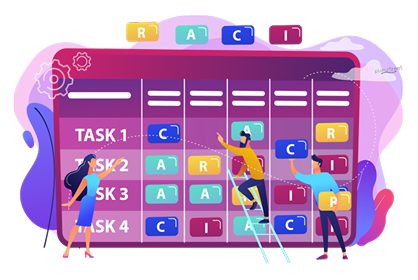RACI chart is a tool used to map roles and responsibilities in a team by defining the activities and scope of each member of the team along with a specific time frame. A RACI chart helps you to know which member is responsible for which task and how far along they are in completing their role. Other members of this team will also be able to view this progress and have to display the progress they have made too.
It is a simple and effective way to map so many variables that arise when multiple members of a team are working on different parts of the same project together. Tracking all the work in a RACI chart will help everyone increase their respective accountabilities. Basic RACI charts are easy to manage. They can get a little tricky when there are too many members, or the project involved is a little difficult, but read on to know how to create and handle a RACI chart like a pro.

Write down your goals
The first step to creating a RACI chart is to jot down the tasks that you need to complete and the goals that the team or the individual needs to achieve. The RACI chart tool is highly flexible and helps teams build the chart for a variety of situations and levels that the project might expose them to. RACI charts may be created at a very organizational and strategic level as well as individual and the micro-level, completely depending on the requirements of the clients.
Write down the members that need to be involved
While formulating the RACI chart, jot down the name of everyone you need to include in the project. It may be done in a list going from left to right in the RACI chart. You have to include these names in an orderly and listed fashion. You need to remember all the members you need in the team and the capacities they are going to work in. These may include the people who own or know the processes, the services, or the product. You may include any required number of managers. Write the roles for these included people down next to them.
The body of the RACI chart
R stands for Responsible, or the people doing the actual work. Think of these people as the worker bees. A manager may also be included in the R category if he/she works in the same capacity on an everyday or regular basis.
A stands for Accountable, who is the person who will be held accountable for the work that is done by the team. In large organizations, the manager is usually the accountable party, and he/she has the responsibility to look after the processes, ownership, and the working of the project. There can only be one person who can be accountable for the activity.
C stands for Consulted, who are the members whom you need to consult throughout the project. They are experts in the subject that the project is concerned with, and they are present in the chart to provide members with any sort of technical and active assistance that they might find themselves in need of.
I stand for Informed are the people whom you need to keep updated in case there is a process change, for example, if you need to tell a member needs that their work profile is going to change during the commencement of the project.

Tips
Get as many Rs as possible. It means that the more people you have who are responsible for doing the actual work, the less pressure falls on one person. If you overload one person with a lot of work, efficiency naturally decreases, and the project completes slower.
Assign the leadership positions like the CIO and the CEO to people who have a working understanding of the day-to-day activities and processes of the project to make a competent decision when such an emergency or need arises. You should not give these positions to the A people, who are held accountable for the completion of the project, or the project’s quality.
Also, the A must have the prerogative to make a decision whenever necessary because he/she’s the person that’s going to be held accountable in the end.
Moreover, accountability, or the A people, should never be outsourced. Accountability rests on your organization. Do not pass on accountability jobs to people who don’t care about how the work turns out to be.




